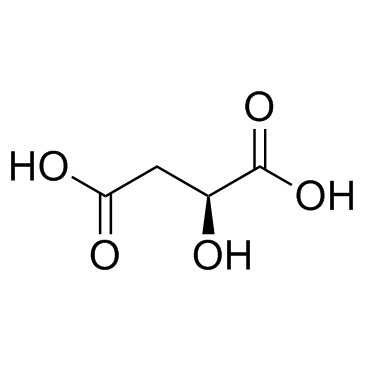L-(-)-Malic acid

L-(-)-Malic acid structure
|
Common Name | L-(-)-Malic acid | ||
|---|---|---|---|---|
| CAS Number | 97-67-6 | Molecular Weight | 134.087 | |
| Density | 1.6±0.1 g/cm3 | Boiling Point | 306.4±27.0 °C at 760 mmHg | |
| Molecular Formula | C4H6O5 | Melting Point | 101-103 °C(lit.) | |
| MSDS | Chinese USA | Flash Point | 153.4±20.2 °C | |
| Symbol |

GHS07 |
Signal Word | Warning | |
|
Physiology and pathophysiology of organic acids in cerebrospinal fluid.
J. Inherit. Metab. Dis. 16(4) , 648-69, (1993) Concentrations of organic acids in cerebrospinal fluid (CSF) appear to be directly dependent upon their rate of production in the brain. There is evidence that the net release of short-chain monocarboxylic acids from the brain is a major route for removing th... |
|
|
Age-related reference values for urinary organic acids in a healthy Turkish pediatric population.
Clin. Chem. 40(6) , 862-6, (1994) Organic acid concentrations were quantified by gas chromatography and the individual acids identified by mass spectrometry in urine specimens from a healthy Turkish pediatric population of ages 2 days to 16 years, subdivided into five age groups. We quantifie... |
|
|
Metabolomic profiles delineate potential role for sarcosine in prostate cancer progression.
Nature 457(7231) , 910-4, (2009) Multiple, complex molecular events characterize cancer development and progression. Deciphering the molecular networks that distinguish organ-confined disease from metastatic disease may lead to the identification of critical biomarkers for cancer invasion an... |
|
|
Automated screening of urine samples for carbohydrates, organic and amino acids after treatment with urease.
J. Chromatogr. A. 562(1-2) , 125-38, (1991) Eighty-five clinical urine samples and nineteen urine samples previously found by other laboratories to suggest genetic metabolic defects were prepared for trimethylsilylation by treatment with urease, followed by azeotropic dehydration. The "Target Analyte S... |
|
|
Quantitative analysis for organic acids in biological samples: batch isolation followed by gas chromatographic-mass spectrometric analysis.
Clin. Chem. 35(4) , 587-95, (1989) This new method for qualitative and quantitative determination of organic acids, aldehydes, and ketones in biological samples is effective for use with urine, plasma, and amniotic fluid, and it requires no deproteinization. Isolation by batch-wise liquid part... |
|
|
Intracellular flux analysis applied to the effect of dissolved oxygen on hybridomas.
Appl. Microbiol. Biotechnol. 44(1-2) , 27-36, (1995) Quantitative estimates of intracellular fluxes and measurements of intracellular concentrations were used to evaluate the effect of dissolved oxygen (DO) concentration on CRL 1606 hybridoma cells in batch culture. The estimates of intracellular fluxes were ge... |
|
|
Highly sensitive GC/MS/MS method for quantitation of amino and nonamino organic acids.
Anal. Chem. 83(7) , 2705-11, (2011) Metabolite profiling methods are important tools for measurement of metabolite pools in biological systems. While most metabolite profiling methods report relative intensities or depend on a few internal standards representing all metabolites, the ultimate re... |
|
|
Levosimendan inhibits peroxidation in hepatocytes by modulating apoptosis/autophagy interplay.
PLoS ONE 10(4) , e0124742, (2015) Levosimendan protects rat liver against peroxidative injuries through mechanisms related to nitric oxide (NO) production and mitochondrial ATP-dependent K (mitoKATP) channels opening. However, whether levosimendan could modulate the cross-talk between apoptos... |
|
|
Antimicrobial activity of sulfur dioxide to certain lactic acid bacteria isolated from wines.
Zhonghua Min. Guo. Wei Sheng Wu Ji Mian Yi Xue Za Zhi 26(3) , 116-31, (1993) This study was conducted to investigate the relationship between pH and the toxicity of sulfur dioxide against homo- and hetero-lactic acid bacteria isolated from American acidic wines. Malolactic fermentation was found to be growth-associated in homo- and he... |
|
|
Heat resistance of Escherichia coli O157:H7 in apple juice.
J. Food Prot. 59(3) , 226-9, (1996) The objective was to determine the effect of cider composition on the heat resistance of Escherichia coli O157:H7. The average D52 value in a model Empire apple juice was 18 min with a z value of 4.8 degrees C. Increasing the Brix from 11.8 to 16.5 degrees ha... |